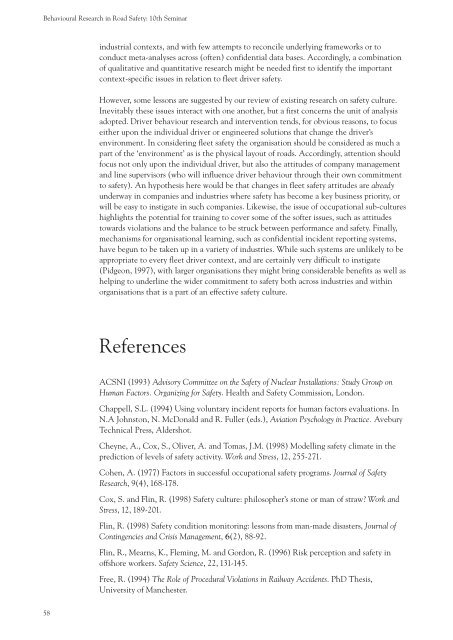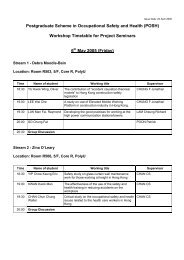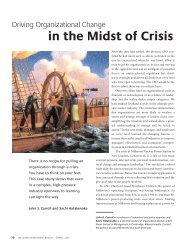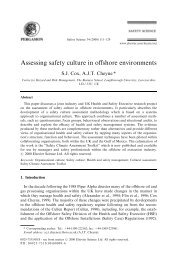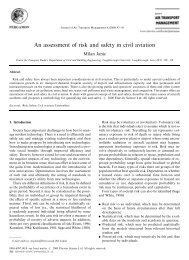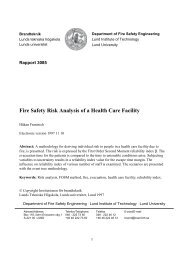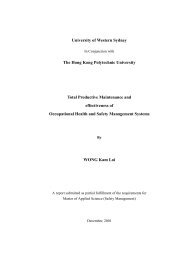Safety culture: transferring theory and evidence ... - Industrial Centre
Safety culture: transferring theory and evidence ... - Industrial Centre
Safety culture: transferring theory and evidence ... - Industrial Centre
- No tags were found...
You also want an ePaper? Increase the reach of your titles
YUMPU automatically turns print PDFs into web optimized ePapers that Google loves.
Behavioural Research in Road <strong>Safety</strong>: 10th Seminarindustrial contexts, <strong>and</strong> with few attempts to reconcile underlying frameworks or toconduct meta-analyses across (often) confidential data bases. Accordingly, a combinationof qualitative <strong>and</strong> quantitative research might be needed first to identify the importantcontext-specific issues in relation to fleet driver safety.However, some lessons are suggested by our review of existing research on safety <strong>culture</strong>.Inevitably these issues interact with one another, but a first concerns the unit of analysisadopted. Driver behaviour research <strong>and</strong> intervention tends, for obvious reasons, to focuseither upon the individual driver or engineered solutions that change the driver’senvironment. In considering fleet safety the organisation should be considered as much apart of the ‘environment’ as is the physical layout of roads. Accordingly, attention shouldfocus not only upon the individual driver, but also the attitudes of company management<strong>and</strong> line supervisors (who will influence driver behaviour through their own commitmentto safety). An hypothesis here would be that changes in fleet safety attitudes are alreadyunderway in companies <strong>and</strong> industries where safety has become a key business priority, orwill be easy to instigate in such companies. Likewise, the issue of occupational sub-<strong>culture</strong>shighlights the potential for training to cover some of the softer issues, such as attitudestowards violations <strong>and</strong> the balance to be struck between performance <strong>and</strong> safety. Finally,mechanisms for organisational learning, such as confidential incident reporting systems,have begun to be taken up in a variety of industries. While such systems are unlikely to beappropriate to every fleet driver context, <strong>and</strong> are certainly very difficult to instigate(Pidgeon, 1997), with larger organisations they might bring considerable benefits as well ashelping to underline the wider commitment to safety both across industries <strong>and</strong> withinorganisations that is a part of an effective safety <strong>culture</strong>.ReferencesACSNI (1993) Advisory Committee on the <strong>Safety</strong> of Nuclear Installations: Study Group onHuman Factors. Organizing for <strong>Safety</strong>. Health <strong>and</strong> <strong>Safety</strong> Commission, London.Chappell, S.L. (1994) Using voluntary incident reports for human factors evaluations. InN.A Johnston, N. McDonald <strong>and</strong> R. Fuller (eds.), Aviation Psychology in Practice. AveburyTechnical Press, Aldershot.Cheyne, A., Cox, S., Oliver, A. <strong>and</strong> Tomas, J.M. (1998) Modelling safety climate in theprediction of levels of safety activity. Work <strong>and</strong> Stress, 12, 255-271.Cohen, A. (1977) Factors in successful occupational safety programs. Journal of <strong>Safety</strong>Research, 9(4), 168-178.Cox, S. <strong>and</strong> Flin, R. (1998) <strong>Safety</strong> <strong>culture</strong>: philosopher’s stone or man of straw? Work <strong>and</strong>Stress, 12, 189-201.Flin, R. (1998) <strong>Safety</strong> condition monitoring: lessons from man-made disasters, Journal ofContingencies <strong>and</strong> Crisis Management, 6(2), 88-92.Flin, R., Mearns, K., Fleming, M. <strong>and</strong> Gordon, R. (1996) Risk perception <strong>and</strong> safety inoffshore workers. <strong>Safety</strong> Science, 22, 131-145.Free, R. (1994) The Role of Procedural Violations in Railway Accidents. PhD Thesis,University of Manchester.58


